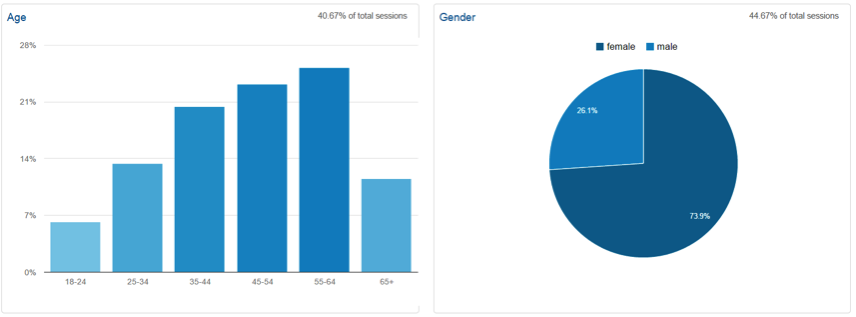
Finish this sentence: “Back in my day…..”
Now imagine that sentence posted on your site, or your Facebook account somewhere. That statement is going to be a big hit with those that identify with it – your generation — and get a collective rolling of the eyes from everyone who doesn’t “get it.”
Speaking to the generational differences of your audience can help bridge the gap with your store and cement a common bond. Creating an online presence that understands and identifies with its customers is a powerful thing for your business.
With an online store, your customer could be virtually anyone from anywhere; back-and-forth conversations have been largely replaced by one-way communication: website content, emails, blog posts – that seemingly need to speak to everyone on that same personal level.
Tailoring your message can mean the difference between making a sale and creating a lifelong customer.
I Know Who My Customer Is…Don’t I?
Online shopping has freed many people to shop at places they might otherwise seem unwelcome. For example, I might be into video games, but don’t like being the oldest person in the store (by far). I can avoid that discomfort by shopping online. In fact, I can feel welcomed to be a part of that online community. As stores move from brick-and-mortar to online sales there is almost always a demographic shift of their customer base, breaking the perception of who they think their customers are.You probably know the makeup of your customer base, but if you want to know for sure, you can use Google Analytics to give you some basic demographic information of your customer (gender, age, area of interests) by making a slight modification to your Google Analytics tracking code.

Writing Content to Different Generations
Tailoring your message to your audience shouldn’t be seen as manipulative, but rather makes them more open to hearing what you have to say. Once you define your audience’s age you can more easily speak to them by discretely using popular culture references of the time, and appealing to their particular ideals and values.We are all familiar, to some degree, with the different imposed descriptions of these age groups, so here is a sample of shared ideologies for the different generations (apologies in advance for lumping you into one of these groups; this is a broad generalization meant only to help us tailor our messaging):
- Baby Boomers (Roughly 50 to 70 years of age): This is a generation that was the first to stand out from the generations before and tends to think of themselves as a special. Closely edit your content for mistakes, this hard-work-ethic generation appreciates the same from you. They like to be complemented and prefer a personal and friendly approach - “You work hard and you deserve to enjoy the finer things.” They are more likely to read lengthy messages, descriptions of products, read and write reviews of products. Keep in mind your design choices as well – younger generations may tolerate small, stylized fonts, but those can be tiring to read in longer paragraphs for this generation.
- Generation X (35 to 50 years of age): Highly educated and active, Gen X seeks a balance between life and work. They appreciate direct communication that quickly points to the benefits of an offer, with facts to back them up - “You don’t have time to shop. Come to Stuff.com where you can compare products at the best price/selection.”
- Millennials aka Generation Y (18 – 34 years of age): Millennials are somewhat more upbeat than older adults about America’s future. They are achievement oriented so creating rewards to incentivize them for going further into your content might be necessary – “Get a free lipstick with any purchase” often works better than a simple discount or free shipping. They appreciate positive and respectful messaging. Having been raised with the Internet, they are its biggest users and often multi-task. Brevity is key and accompanying your messages with lots of imagery goes a long way with Millennials. When writing longer content (blog posts, emails, etc.) to this group, make sure your headline or subject line is very engaging or they will most likely not read any further.
- Generation Z aka iGeneration (Teens and younger): The first generation to have been raised on current technology, they are accustomed to the changing nature of media. They live in an always-online state, persistently connected to their friends and online resources, which they often look to for solutions. They are typically not brand loyal. To reach out to this group you’ll want to create a visual, interactive experience - “Design your own shoes with your own patterns and colors at Stuff.com.”
Using Different Methods to Target Different Age Groups
Creating a variety of messaging centered on different demographic groups doesn’t mean you need to create separate websites to deliver them. There are a ton of ways to get your message out there that speak to the different age groups. There is plenty of overlap between these platforms, but here is a brief guide to targeting your audience:- Email: Short, “special offer” emails with catchy subject lines – best for Boomers, Gen X and Millennials
- Email Newsletters: Longer form emails with more content and delivered on a regular basis – best for Boomers and Gen X
- Blog Posts: Best for Boomers. Product reviews and comparisons are appreciated by Gen X
- Facebook: Despite its youthful beginnings, Facebook has grown to be used more and more by Boomers and Gen X, and to a lesser extent, Millennials, to stay in touch with friends and family and identify products and business they love
- Twitter: These short bursts of communication are used most frequently by Millennials
- Instagram: Pictures and more pictures! Millennials and Gen Z
- Pinterest: Groups of pictures! Millennials and Gen Z
- Online Advertising: PPC and Banner ads can be directed to targeted groups by browsing and searching habits, but are generally acted upon by just a few groups - Boomers, Gen X and Millennials
- Snapchat: Fun and temporary – Gen Z primarily
- YouTube: A source of information, entertainment and expression – Millennials, Gen Z and a rapidly growing number of Boomers
- Phone calls: Not surprisingly, Boomers are just about the only generation that appreciates communicating over the phone anymore











